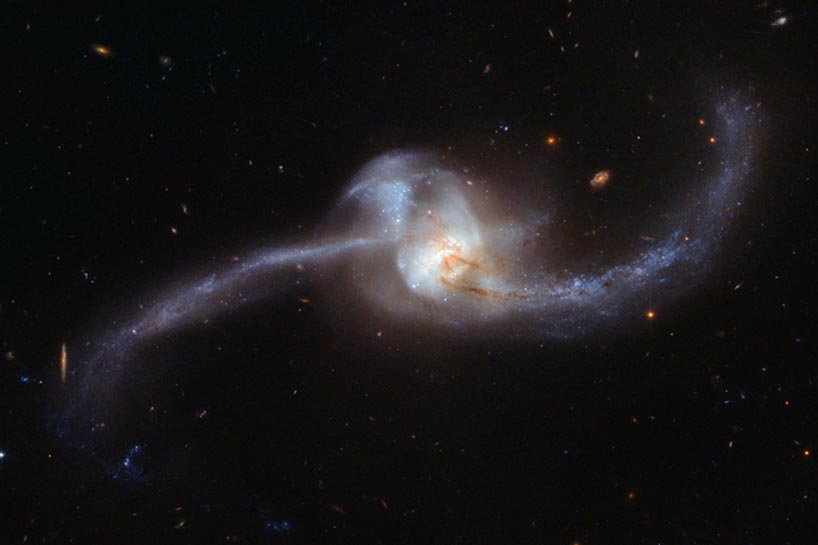
Interacting Galaxy
RA 8h 38m 23.99s Dec 25° 45' 19.27"
Cancer
260 million light years
13.4
2.4 x 0.7 arcmin
3.32 x 1.59 arcminutes
North is 134.8° right of vertical
ESA/Hubble & NASA
October 16, 2017
2009 image: G0912
ABOUT THIS IMAGE:
This image, captured by the NASA/ESA Hubble Space Telescope, shows what happens when two galaxies become one. The twisted cosmic knot seen here is NGC 2623 — or Arp 243 — and is located about 250 million light-years away in the constellation of Cancer (The Crab).
Not surprisingly, interacting galaxies have a dramatic effect on each other. Studies have revealed that as galaxies approach one another massive amounts of gas are pulled from each galaxy towards the center of the other, until ultimately, the two merge into one massive galaxy. NGC 2623 is in the late stages of the merging process, with the centers of the original galaxy pair now merged into one nucleus, but stretching out from the center are two tidal tails of young stars, a strong indicator that a merger has taken place.
NGC 2623 gained its unusual and distinctive shape as the result of a major collision and subsequent merger between two separate galaxies. This violent encounter caused clouds of gas within the two galaxies to become compressed and stirred up, in turn triggering a sharp spike of star formation. This active star formation is marked by speckled patches of bright blue; these can be seen clustered both in the center and along the trails of dust and gas forming NGC 2623’s sweeping curves (known as tidal tails). These tails extend for roughly 50,000 light-years from end to end. The prominent lower tail is richly populated with bright star clusters. These star clusters may have formed as part of a loop of stretched material associated with the northern tail, or they may have formed from debris falling back onto the nucleus. In addition to this active star-forming region, both galactic arms harbor very young stars in the early stages of their evolutionary journey.Many young, hot, newborn stars form in bright stellar clusters — at least 170 such clusters are known to exist within NGC 2623.
NGC 2623 is in a late stage of merging. It is thought that the Milky Way will eventually resemble NGC 2623 when it collides with our neighboring galaxy, the Andromeda Galaxy, in four billion years time.
In contrast to the image of NGC 2623 released in 2009, this new version contains data from recent narrow-band and infrared observations that make more features of the galaxy visible.